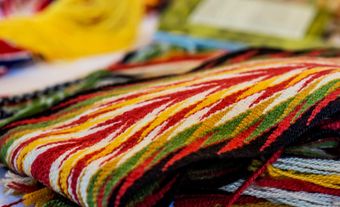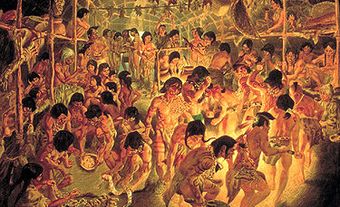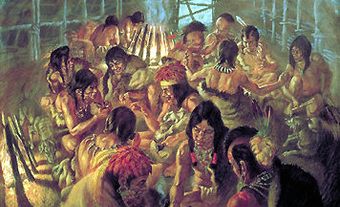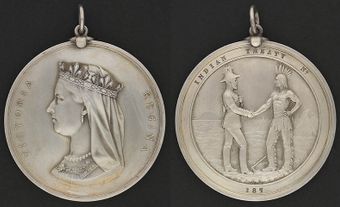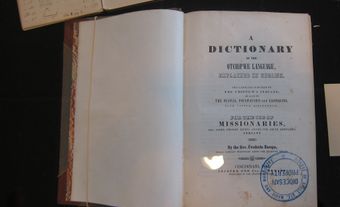The term a dish with one spoon refers to a concept developed by the Indigenous peoples of the Great Lakes region and northeastern North America. It was used to describe how land can be shared to the mutual benefit of all its inhabitants. According to the Haudenosaunee (Iroquois), the concept originated many hundreds of years ago and contributed greatly to the creation of the “Great League of Peace” — the Iroquois Confederacy made up of the Seneca, Cayuga, Oneida, Onondaga, and Mohawk nations. The Anishinaabeg (the Ojibwe, Odawa, Potawatomi, Mississauga, Saulteaux and Algonquin nations) refer to “a dish with one spoon” or “our dish” as “Gdoo – naaganinaa.”

History, Symbolism and Practices
A “dish with one spoon” was often mentioned by Indigenous peoples while making treaties with one another to avoid violent conflict. The “dish” represents the land that is to be shared peacefully and the “spoon” represents the individuals living on and using the resources of the land in a spirit of mutual co-operation. Often, a bowl or kettle was referred to rather than a dish.
Ceremonies were held to celebrate the making of a treaty. At these ceremonies, the parties involved would exchange wampum belts to symbolize their agreement. The wampum belts were elaborately decorated with intricate beadwork and sometimes depicted a bowl, kettle or spoon. These were valuable objects as they signified a lasting relationship. Ideally, treaties were meant to last a long period of time. The wampum belt was, in effect, a record of a diplomatic agreement. Like all diplomatic agreements written on paper its purpose was to ensure that the parties would “keep to their end of the bargain.” They were also intended to ensure that memory of the agreement would be preserved.
Perhaps the best-known wampum belt is the one that symbolizes the treaty made between the Haudenosaunee and the Anishinaabe peoples prior to the coming of the Europeans. One of the more important peace treaties between these peoples was ratified in Montreal in 1701. This event is called “The Great Peace of Montreal,” a treaty between the French (see New France), the Haudenosaunee (Iroquois Confederacy) and many other Indigenous nations. The Great Peace of Montreal ended decades of warfare that raged throughout the seventeenth century (see Iroquois Wars). Approximately 1,300 Indigenous people attended. This two-week event was marked with feasting, the smoking of pipes, the exchange of wampum belts and speeches by Indigenous leaders. During their speeches, at least one of these leaders referred to a dish with one spoon.
Treaties with Europeans and Settler Governments
When making treaties with the European powers and settler governments, Indigenous peoples continued to observe the concept of a dish with one spoon. However, the European powers and settlers had a much different view than Indigenous peoples when making treaties. The European powers and settlers believed in the concept of private property (see Property Law). Therefore, they could not, or would not, try to understand the notions behind a dish with one spoon. So, there was often much confusion on the part of Indigenous peoples when making treaties. They believed that land was to be shared by all, not simply the possession of one group or people forever (see Religion and Spirituality of Indigenous Peoples in Canada).
When discussing the treaties made between Indigenous peoples and the British and Canadian governments during the 19th century, Peguis First Nation educator Wabi Benais Mistatim Equay (Cynthia Bird) noted: “First Nations peoples never envisioned that the long-term outcome of…Treaty relations would be their occupying less than three per cent (3.5 million hectares) of their homeland, on 617 small communities the federal government calls ‘reserves.’”
“A Dish with One Spoon” in Contemporary Canada
Recently, many scholars and Indigenous peoples have come to believe that the dish with one spoon concept can raise awareness regarding ecological and environmental sustainability. One of the core values within the idea of a dish with one spoon is that those who use the land should not abuse the land. In other words, individuals and groups should only take what they need from the land so that there will be a healthy, long-term, sustainable environment. When speaking on this point, Anishinaabe and Métis historian and educator Karine Duhamel wrote that “all participants in the agreement [or treaty] had the responsibility to ensure that the dish would never be empty by taking care of the land and all of the living beings on it.”
In addition to environmental sustainability, another important idea inherent within a dish with one spoon is the relationship between different Indigenous nations. Leanne Simpson, an expert on the Anishinaabeg, has argued that a dish with one spoon enabled First Nations to recognize each other’s independence and distinct identity. According to the dish with one spoon philosophy, all parties to a treaty would share the land. However, they would maintain their sovereignty. In other words, a dish with one spoon recognized the diverse nature of Indigenous nations and cultures.
In the past few years, Canadian institutions have recently begun to formally acknowledge that they are situated on Indigenous territory in land acknowledgement statements. These statements are usually given before the opening of meetings, events and ceremonies. Universities and colleges were among the first institutions to issue such statements. As of 2017, seven of them have made references to a dish with one spoon. For example, McMaster University’s land acknowledgement statement reads:
We [I] would like to begin by acknowledging that the land on which we gather is the traditional territory of the Haudensaunee and Anishnaabeg. This territory is covered by the Upper Canada Treaties, is within the lands protected by the “Dish With One Spoon” wampum agreement and is directly adjacent to Haldimand Treaty territory.
The statement from the University of Toronto (Mississauga Campus) is similar:
We [I] would like to begin by acknowledging that the land on which we gather is the traditional territory of the Haudensaunee and Anishnaabeg. This territory is covered by the Upper Canada Treaties, is within the lands protected by the “Dish With One Spoon” wampum agreement.
Significance
A dish with one spoon was a concept that enabled the Indigenous peoples of the Great Lakes region and northeastern North America to negotiate peace agreements and attempt to live sustainably. However, this concept led to many misunderstandings on the part of the Indigenous peoples when they were signing treaties with the European powers and settler communities in the past. While the Europeans and settlers believed these treaties gave them permanent control over the land, Indigenous peoples believed that they would be sharing the land (see Property Law and Religion and Spirituality of Indigenous Peoples in Canada). Until recently, a dish with one spoon was little known outside of Indigenous communities. Starting in the 2010s, more Canadians have become aware of it. Perhaps this knowledge will help to foster a spirit of reconciliation since the acquiring of knowledge concerning Indigenous history, culture and philosophy is the first step in this process.

 Share on Facebook
Share on Facebook Share on X
Share on X Share by Email
Share by Email Share on Google Classroom
Share on Google Classroom


